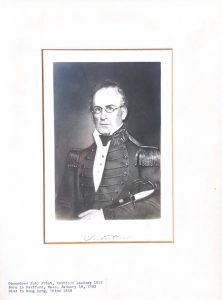Lithograph of Commodore Joel Abbot
Joel Abbot was born in Westford 1793. Though enrolled in Westford Academy in 1812, Joel opted for a career in the US Navy, and was appointed a midshipman on the frigate President at the outbreak of the War of 1812. He was under the command of Commander John Rogers, later impressing Rogers enough to become his aid and Signal Officer. He was involved in some controversies post-1812, including a court marshal in 1822. However, his long career resumed by 1825. In the 1840s, he served in Commodore Perry’s African Squadron, commanding the sloop-of-war Decatur, and was promoted to Captain in 1850. Soon after, he was appointed Commodore of the East India Squadron (the coast of China and Japan), which included his flagship Macedonian. Abbot successfully engaged Chinese pirates at this time. By 1885, he died of malaria, but his mission was deemed successful, being commended by the Secretary of the Navy that same year.
More info in Joel Abbot and the ship named after him may be found at Abbot.us
Click to expand for transcription of bio by unknown author on reverse of frame:
COMMODORE JOEL ABBOT
Joel Abbot was born in Westford, Massachusetts, the 18th of January 1793. In 1812 Mr. Grace, the Preceptor of Westford Academy, sent a communication to the Trustees saying: “he had excluded from the school a young man (Joel Abbot) who had neglected to attend the meeting on Fast Day, in order to procure a company of young men to train on the common in the forenoon, and for entering the meeting house in the afternoon in an improper dress, being partly military, also for aiding and assisting in firing a blunderbuss several times in the street, not far from the meeting house, soon after meeting on said day, and for refusing to make any written acknowledgement of the impropriety of his conduct.”
Joel Abbot married on the first of January 1820, Mary Wood of Newburyport, and second, Laura Wheaton of Warren, Rhode Island. He died in Hong Kong, China, the 14th of December 1855.
Joel Abbot was appointed a midshipman at the outbreak of the second war with England, 1812, and was ordered to the frigate “President”, as aid and signal officer to Com. Rodgers who impressed by his zeal and efficiency, recommended him to Com. McDonough, then in command of the naval forces on Lake Champlain. Learning that the British had accumulated a large supply of spars at Sorel, McDonough sent for Midshipman Abbot and asked if he was willing to die for his country. “Certainly, Sir, that is what I came into the service for”, was the answer. McDonough then told him what he wished done, and young Abbot, disguised as a British officer, entered the enemies lines, taking the risk of being hanged as a spy in case of capture, discovered where the spars were stored, and destroyed them. Such were the hardships and dangers encountered during the expedition that when he reported to his commanding officer he was in a state of prostration from the effects of which he was long in recovering. For this exploit and for gallantry in action off Cumberland Head, 11th of September, 1814, he was promoted Lieutenant, and congress voted him a handsome sword. During the remainder of the war he had no further opportunity for distinction, though at one time he quelled a formidable mutiny. In December 1818 he was placed in charge of a 30-gun pirate craft, the “Marianna” captured by Com. Stocton off the African coast. On the voyage to Boston part of his crew mutinied and the pirate prisoners succeeded in wrenching off their irons, during a terrible gale. Notwithstanding the seemingly hopeless state of affairs, Lieutenant Abbot regained command of the crew, kept the mutineers at bay, and brought his ship safely into port. In 1838 he was appointed Commander, serving on the various foreign squadrons and from 1839 to 1842 was in command at the Boston Navy Yard. In 1852 he commanded the Macedonia in the Japan expedition, succeeding Com. Perry as flag officer of the squadron. During the critical period of our relations with China he was often called upon to perform delicate diplomatic duties, discharging them to complete satisfaction of the Government. He probably shortened his life by devotion to the interest of commerce in personally superintending the placing of buoys and a light ship in the harbor of Shanghai, which for the first time then had its channels and sailing course properly defined.
1940 U.S.S ABBOT RETURNS TO ACTIVE DUTY
The United States destroyer Abbot (184), named in honor of a Westford naval officer (Joel Abbot), has been recommissioned for active service and is now on neutrality patrol in the Atlantic. She sailed from Philadelphia navy yard last week, on her first sea voyage since 1922. The Abbot, which will be turned over to Great Britain, bears the name of Commodore Joel Abbot, U.S.N, a doughty seaman of a century ago, who distinguished himself as a fighter, a diplomat, and a navigator.
The destroyer Abbot was built under the World War appropriations. She was launched July 4, 1918, with sisters named Crane, Elliot, Gridley, Haraden, Harding, McKean, Thomas, Upshur, and Williams. The Abbot was not commissioned until July 19, 1919, work on her slowing up after the Armistice. She is a 314 foot, 1213-ton, 24-knot destroyer, armed with four four-inch guns, one three-inch anti-aircraft gun and 12 21-inch torpedo tubes. Her normal crew in eight officers and 124 men. When she was ready for service, the Abbot was assigned to Destroyer Division 19, of the Atlantic fleet. She operated with the fleet during 1919-22 and for a brief time was assigned duty in European waters. The Abbot was decommissioned at Philadelphia in 1922, with nearly 200 other war vessels, as an economy measure. She lay idle there until a few weeks ago, then was hauled out of storage, overhauled and placed in first class condition again. During her period of inactivity, she was kept serviceable by a care and maintenance party.
Lithograph
14-1/2″ x 11 1/4″ (framed)
Wood frame, black
Paper, matted
W.1989.21.1c

